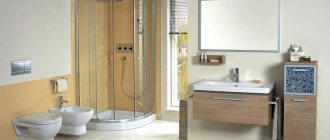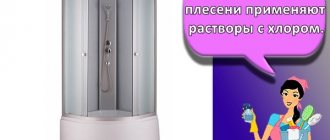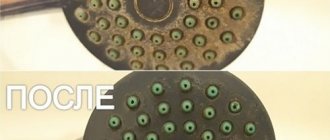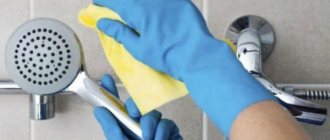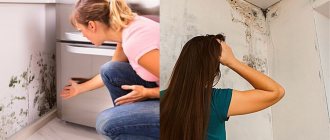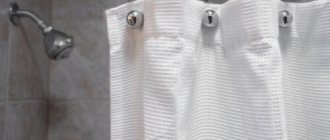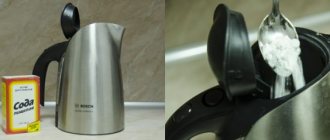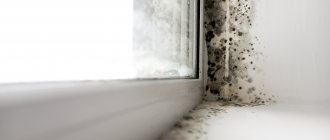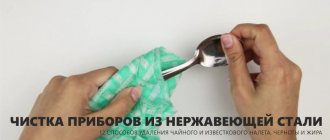You can clean your shower stall from lime and soap deposits, rust or mold if you know a few tricks. Household chemicals (for example, Acrilan, Cif cream, Cillit bang, Mister Muscle, Domestos) or the old “old-fashioned” methods with soda, salt and ammonia will help against white stains. To cope with rust, housewives are advised to use Domestos liquid cream, table vinegar or citric acid.
We must remember that a raid is not the worst thing that can happen to a cabin. The appearance of mold and multiplying bacteria on its walls threatens not only cleanliness, but also health. Therefore, such pollution should be taken seriously.
Many new apartment buildings are now being built from reinforced concrete columns, as they are highly stable and reliable.
What causes soap stains and limescale deposits?
Even if tap water meets the standards, it contains mineral salts. After a shower, water droplets remain on the glass surface. If they are not wiped off immediately, they dry out: the moisture evaporates, but the sodium and calcium remain in place, forming unsightly white marks.
Glass surfaces
Caring for the glass surfaces of shower cabins does not involve the use of scratching abrasives or chemically active agents.
Experts recommend giving preference to the following compositions:
- Tilex Fresh-Shower;
- Luxus “Clean Bath”;
- Frosh Essig Reiniger;
- spray "Mr. Muscle";
- Amway.
The easiest way to clean tempered shower glass is with OROfresh, Luxus, Delu and Mister Muscle. The surface washed with this product is rinsed with clean water and wiped dry with a piece of soft cloth.
To clean expensive shower stalls and hydroboxes with glass doors and walls, it is allowed to use products that are intended for washing mirror surfaces or windows.
Prevention of limescale deposits on shower glass
It will not be possible to completely prevent contamination, but you can save yourself from frequent cleaning with the help of simple means.
- After taking a shower, wait until all the water has drained and wipe off any remaining drops with a dry cloth. The cabin will remain clean and there will be no deposits.
- Ventilate the shower: ideally, it should be left open until completely dry. This simple method will also prevent mold from occurring.
- If forced ventilation is installed in the bathroom, cleaning will have to be done less often.
- Treat glass joints and contact areas with plastic, ceramics, and metal with protective compounds. They have a hydrophobic coating, which results in much less sediment.
- When rinsing the shower after yourself, do not use water that is too hot. After it, the adhesion of calcium, iron and sodium to the glass surface becomes stronger, and it is more difficult to wash off whitish traces than after a cold rinse.
Himitek Polycor-Gel
Himitek cleaning gel, produced in Russia, is designed to clean shower stalls, but also other various bathroom surfaces. The thick consistency holds the gel well on vertical surfaces.
The gel is gentle on chrome surfaces due to the presence of orthophosphoric acid in its composition. The product is effective against limescale, rust, and stubborn salt deposits formed when using hard water.
Himitek Polycor-Gel is a hypoallergenic substance, which is especially important for people with sensitive skin and allergies. Leaves a pleasant aroma after use.
Himitek Polycor-gel, acid concentrate.
Prevention of soap stains
Preventing the appearance of soap marks is as easy as shelling pears - switch to using shower gel or cream.
Choose beauty products that are quickly washed off the body. They have a special composition with high sliding properties. It will help avoid soap stains - caps of foam will remain on the door and walls, which are completely washed off when rinsing. If you don’t want to change your usual products to new ones, after each shower, do a quick cleaning of the surfaces with a rubber scraper. This takes 1-2 minutes and prevents the appearance of a white residue.
Preventive treatment of glass panels with a mixture of ammonia and water (a spoon per liter) once every 2 weeks will help reduce the interval between general cleanings.
Factors that determine the rate of contamination of plumbing fixtures
During operation, dust settles on plumbing fixtures, deposits and stains from detergents accumulate, and drying drops of water leave traces of salts and rust particles. The faster surfaces become dirty, the more often routine and general cleaning must be done. What determines the speed at which the shower stall becomes dirty?
Supplied water quality
The water supplied to homes through pipelines varies in hardness in different regions. Water becomes hard as it percolates through limestone and chalk deposits and becomes saturated with minerals.
Such water leaves traces in the form of plaque on the walls and shower tray, scale in kettles and water heaters, and clogs small holes in the shower head.
The quality of water is also affected by the pipes through which it is supplied. If they are worn out, a rust-colored liquid with an unpleasant odor enters the apartment. Such water leaves yellowish marks on all surfaces with which it comes into contact, white plumbing is especially affected.
Availability of filters
The negative impact of poor quality water can be mitigated by installing filters. It is optimal to connect several filters at the input that perform coarse and fine cleaning.
Care products used
Plumbing fixtures will get dirty faster if the cleaning products and tools are chosen incorrectly. Abrasives and hard brushes damage the surface, leaving scratches, sometimes even invisible to the eye, in which already noticeable dirt accumulates.
What are water-repellent glass coatings and why are they needed?
The most effective prevention, which does not require extra effort to maintain cleanliness, is the application of a hydrophobic coating during the production of the product. It repels lime deposits and detergent residues, prevents the formation of plaque and makes everyday work much easier for the housewife. This is an additional option offered by leading manufacturers, including.
In addition, there are water-repellent products for shower glass for home use. Their composition is reminiscent of those aerosols that are applied to car mirrors for better visibility in bad weather. Fluorine-containing compounds create an “Anti-drop” effect. They do not allow water flows to linger in the form of drops, so until the water repellent is completely washed off, almost no plaque is formed.
spring-cleaning
Once every 10–14 days, you should thoroughly clean the shower stall to remove various contaminants. General cleaning should also be carried out in cases where the structure has not been used for a long time, for example, you were away.
General cleaning is carried out in several main stages:
- Cleaning walls and plastic elements. Get rid of lime deposits and other types of dirt. To do this, apply the selected product to the surface, leave for a while and rinse with clean water. When cleaning walls, pay special attention to the seams between tiles, as this is a favorite place for mold to grow.
- Washing glass doors. Wash the glass thoroughly to remove soap stains. Special sprays for windows and glass will cope well with this task. A solution of vinegar, citric acid or ammonia is also suitable. Use the product according to the instructions, then wipe dry with a soft cloth.
- Cleaning chrome elements. Thoroughly clean the mixer, hydromassage head and other elements from mineral salts. Using purchased or folk remedies, restore their attractive shine.
- Washing the tray. At the last stage, you need to wash the tray. When choosing a detergent, consider the material from which it is made. For example, for acrylic pallets it is strictly forbidden to use compounds containing formaldehyde or formic acid. Enameled pallets are more resistant to chemicals, but it is better to avoid abrasives.
When you go to do general cleaning in the shower stall, arm yourself with the following tools and devices:
- soft rags and microfiber;
- spray bottle;
- rubber scraper;
- foam sponge;
- toothbrush.
Removing limescale from the shower stall - video:
The use of hard brushes and metal scrapers is prohibited as they may leave scratches.
Advice! If old stains cannot be removed using traditional methods, use a steam cleaner. No dirt can resist the pressure of hot steam.
How to apply a water-repellent coating: step-by-step instructions
The surface must be thoroughly washed, especially joints and seams.- Wipe with a dry cloth or wait until it dries naturally.
- Degrease with alcohol, ammonia or a special degreaser.
- Apply a hydrophobic glass cleaner to a non-woven fiber cloth. Treat the shower stall with it.
- Remove the matte “film” that appears by polishing movements using microfiber.
- Having done everything according to the rules, you will receive protection for an average of 2-3 months.
Important condition! If the shower room is below +10°C during treatment, the product will not fix.
Mold Removal
Fungus grows in the shower stall due to dampness and poor ventilation. Remove mold stains with chlorine-containing compounds, vinegar, alcohol or soda.
The product should be selected taking into account the type of surface.
The reasons for the appearance of fungus in the shower stall are constant dampness.
To remove foci of mold, an antiseptic composition is applied to the stain, left for 30-40 minutes, the dirt is removed with a sponge, and washed off with hot water. It is better to clean hard-to-reach places with a toothbrush.
To prevent the fungus from growing again, it is recommended to wipe the cabin dry after use and regularly ventilate the bathroom.
How to remove plaque from shower glass
The tips listed above will reduce the need for thorough cleaning of the cabin to once a week.
But you still have to do some general cleaning. The easiest way to remove stains is with a steam generator. Even a small mobile model will do. It will soften the plaque, but will not completely remove it; additional devices and products will be needed. For example, a rubber scraper, which is used for washing windows, will help out.
Rough sponges or metal floats are prohibited - glass will corrode when used. Small scratches form on it, which deprive certain areas of their shine, plus plaque and dirt get deeper into the microcracks.
The best way to clean your shower is:
- soft non-woven napkins;
- microfiber cloths;
- melamine sponge.
Cleaning hydromassage jets
You can remove plaque and scale inside hydromassage jets using heated table vinegar or store-bought lime cleaning products:
- "Cilit";
- "Prosept";
- "Unicum";
- "Zero" and others.
Silit Beng for cleaning injectors.
The entire area of the nozzle is covered with the composition and left to corrode the deposits for 10-15 minutes. Then use a sewing needle to clean the holes, and then rinse off the cleaning solution with water.
How to remove stains from shower glass
Those who prefer traditional folk recipes for cleaning the house can use the same life hacks for the cabin as for cleaning windows and mirrors. The main thing is that the cleaning compositions are in the form of liquids or sprays. A creamy or mushy texture will work, but not a powder.
- White vinegar 6% (1 tbsp per 1 glass of water). You can pour it into a container with a spray bottle or moisten microfiber with the resulting solution.
- Citric acid (200 ml sachet of hot water). To remove plaque, apply the mixture and leave for 15 minutes.
- Ammonia (20 ml per 1 glass of water). This recipe gives the glass a brilliant shine, but has a pungent odor.
- Pharmacy hydrogen peroxide. Moisten a cloth with it, wipe it and wash it off after 10 minutes.
- Alcohol / Vodka. They need to be sprayed and wiped with a non-woven cloth.
Professional detergents and household chemicals
Any cleaning product that contains chemicals and elements should be used in everyday life with reasonable caution. This is especially true when small children and people with allergies live in the house, as they can cause allergic reactions, external irritations (eyes and skin), and also have a negative impact on the functioning of the respiratory system.
The most popular and proven detergents today include:
- "Acrilan" is a product with an unpleasant odor, especially suitable for cleaning acrylic products.
- "Cilit" requires careful handling and is prohibited for use when cleaning aluminum and natural stone surfaces.
- Tilex is used for preventive purposes to prevent the formation of complex contaminants (mold, plaque and stone). Easily copes with fat and does not require rinsing. Smells strongly of chlorine.
- "Cif" is often used when cleaning and washing acrylic. Easily whitens and removes rust.
- "Sanelit" - suitable for cleaning acrylic surfaces. It has a sharp, specific smell.
Traditional folk methods also keep up with professional manufacturers of washing cleaners. For the most part, these recipes consist of natural ingredients and improvised means.
Special household products for cleaning shower glass
If you don’t believe in folk recipes or want to save time, use store-bought products. They contain substances that effectively remove all types of contaminants, are adapted to the properties of the glass sheet and do not leave streaks behind. Cillit Bang Power Cleaner, LOCPlus, Clin “Windows and Glass”, Cif “Ultrafast”, Mr. Muscle with ammonia, etc.
Allergy sufferers, families with children and the elderly, as well as anyone who cares about their health are recommended to clean using natural household chemicals without harmful components. Similar options can be found in the brands Levrana, Weleda, Botavikos, Ecover, Organic People, Bio Mio, Wonder Lab, etc.
How to wash a tray
Before cleaning the pallet, we determine the material with which we will have to work, since each of them has its own specific features and contraindications. Acrylic is considered the most capricious and picky. When cleaning such surfaces, the following are prohibited:
- hard sponges;
- acetone;
- alkali;
- alcohol;
- cleaning powders.
Dirt from acrylic surfaces is removed using soft cloths or toothbrushes, laundry soap, gentle liquids and dishwashing detergents are used, as well as special formulas and substances intended for acrylic surfaces.
If the pallet is made of stone, it requires minimal maintenance. The material is resistant to chemical influences, and therefore any cleaning agent is suitable for removing limescale. Artificial stone does not exclude further loss of color and brightness of the product; experts recommend using any plumbing product for toilets (Santry, Cillit Bang, Domestos).
Alkali, formaldehyde, sulfuric and hydrochloric acids are dangerous when caring for enamel trays. The most important assistants in protecting enamel surfaces will be Pemolux and Comet.
Plastic does not like alkali, formaldehyde, acids, cleaning powders and alcohol.
Safety rules when cleaning plaque
The shower stall is an enclosed space.
Even if glass panels and screens do not reach the ceiling, bathroom space is limited. Care must be taken not to inhale fumes from aggressive cleaning agents. Remember that even if you are completely healthy now, cumulative allergies may develop over time. To avoid this, do not neglect safety precautions when cleaning surfaces from plaque.
- Use a household respirator.
- Wear rubber gloves on your hands.
- Leave the door to the room open during treatment.
- If your shower room has windows, open them.
- Use forced ventilation.
- Do not use products containing high chlorine content.
- Do not use hot water: steam combined with chemical fumes will quickly lead to illness or fainting.
***
Now you know how to clean shower glass, and how to clean much less frequently. A properly selected arsenal of care products will not only help cope with dirt, but also keep glass structures in their original form: transparent, shiny and new.
Types of cleaning
Keeping your shower stall clean is much easier than later dealing with stubborn dirt, limescale and mold. Therefore, you need to clean it 2-3 times a week, and not from time to time when difficult to remove stains and blockages appear.
How to easily clean shower glass?
The condition of the glass is the first thing people notice when visiting the bathroom, so it’s worth paying special attention to them. Purchased products (Clin, Meine Liebe) are suitable for cleaning; simply spray them over the surface and leave for the period indicated on the package, and then rinse off.
Any other household chemical for cleaning mirrors and glass will cope with this task. For example, Mister Muscle for windows.
If the cabin windows have a smooth surface, you can use a special scraper. It is very convenient: on one side there is a sponge, and on the other there is a thick rubber gasket, thanks to which the product and water are removed, and the glass remains practically dry and does not require additional wiping.
How to clean a shower tray?
When choosing a tray cleaner, you need to know what material it is made of. Acrylics cannot be washed using abrasive and bleaching components, as they destroy the surface, resulting in more and more contamination.
Any white toothpaste (New Pearl Whitening, Lacalut White) is good for removing small stains. It is applied and rubbed a little with an old brush.
You should not use colored pastes, even those with a whitening effect, because they contain dyes that can change the color of the pallet.
Lemon juice applied for 20-30 minutes will restore the whiteness of acrylic. But if you need to treat the entire pallet, it is better to use factory-made products. For example, Cif cream or Acrilan spray.
Toilet cleaning fluids work well for the bottom of a natural stone stall, but they contain active chemical acids. It is worth wearing gloves and rinsing the tray itself with running water with special care.
When dirt forms at the joints, a steam generator is good; just walk it over the problem areas, and then use a sponge and water to remove the dirt.
How to get rid of a blockage?
To do this, use a plunger. You need to attach it to the drain hole and press the handle several times, after which the lump that has clogged the drain will come out.
For the same purpose, you can use household chemicals that dissolve accumulated organic particles (hair, etc.). Preference should be given to imported ones, as they have a more gentle effect on modern materials used for the manufacture of siphon parts and pipes. Tiret has proven itself well. It can be used to remove both soap and other deposits, and is also suitable for use in preventing blockages. Eliminates unpleasant odors as it has disinfecting properties.
Some housewives prefer proven home remedies. Baking soda and vinegar works well for clearing clogs in the shower. Approximately 200–300 g of the first is poured into the drain hole, and then 70% vinegar is added, wait until the end of the reaction (the foam stops releasing) and rinse with water. To enhance the effect, use a plunger.
How to clean mold from a shower stall?
Fungus actively develops in the bathroom, which is associated with high humidity. This is not just a problem with showers. You need to try to prevent the appearance of mold, as it is difficult to get rid of. The fungus penetrates the structure of materials with increased porosity; as a result, not just general cleaning is required, but repairs are required, since it is impossible to remove it from there.
To reduce humidity in the bathroom, install a special fan that helps get rid of it quickly and for a long time. After using the shower stall, you should leave its doors open until dry.
You need to pay special attention to the joints, because they are sealed with a special agent that has a porous structure, and water also flows there. Therefore, when carrying out general cleaning in the shower (about once a month), it is necessary to treat them with chlorine-containing compounds. For example, Whiteness, Domestos. These products are applied to the joints and left for several hours, then washed with plenty of water. Then wipe dry.
You need to remember about safety - wear gloves and open the door to the bathroom to avoid poisoning from chlorine-containing products.
If mold does appear, it will be extremely difficult to remove. The most effective way is to replace the seam sealant with a new one, and then maintain cleanliness and prevent the fungus from appearing again.
If you use the techniques described above to clean the shower stall, there will be no problems. The main thing to remember is that it is easier to prevent the appearance of any types of dirt and blockages than to get rid of them.
